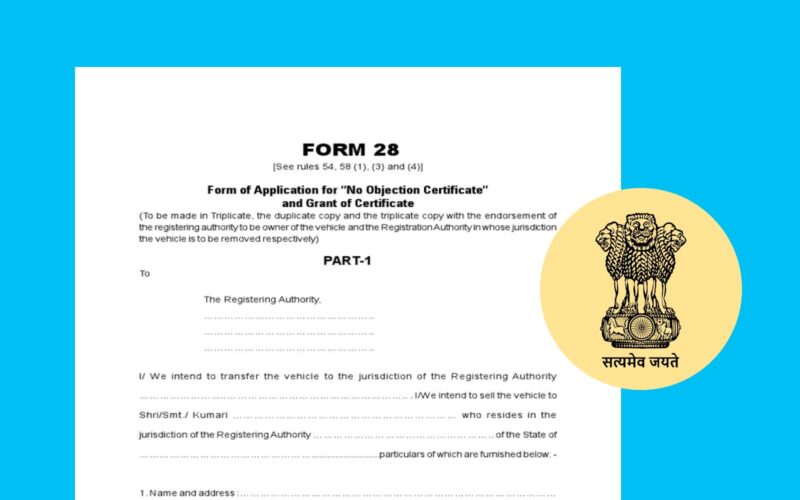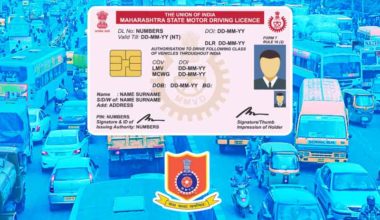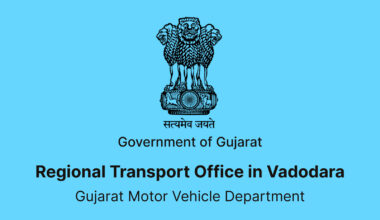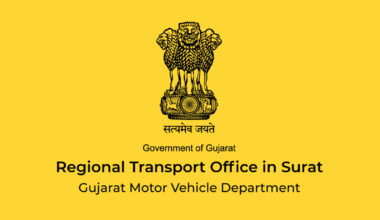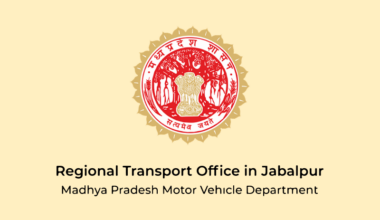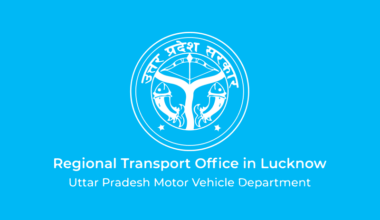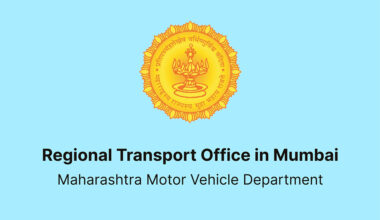In the world of vehicle registration and licensing, numerous forms are utilized to streamline processes and ensure compliance with regulations. One such form is Form 28, which serves a specific purpose within the Regional Transport Office (RTO). In this blog post, we will delve into the use of Form 28 and provide a step-by-step guide on how to fill it accurately.
What is Form 28?
Form 28 is an essential document issued by the RTO, primarily used for obtaining a ‘No Objection Certificate’ (NOC). This certificate is required when an individual intends to transfer the ownership of a vehicle to another state or district within India. Form 28 serves as an application for granting such a NOC and facilitates the smooth transition of vehicle ownership across regions.
Why is Form 28 Necessary?
When a vehicle owner wishes to relocate or permanently move their vehicle to a different state or district, obtaining a NOC is mandatory. This certificate validates that there are no pending dues or legal issues associated with the vehicle. Additionally, it ensures that the transfer is lawful and legitimate.
Documents Required to Fill Form 28 of RTO
When filling out Form 28 of the Regional Transport Office (RTO), you will typically need to attach certain documents to support your application. While the exact document requirements may vary slightly depending on your specific RTO, here is a list of commonly required documents-
| Document Name | Requirement |
| Proof of Address | You will need to provide a document that verifies your current address. Accepted documents may include a copy of your Aadhaar card, passport, voter ID card, ration card, or utility bills (electricity bill, water bill, etc.) in your name |
| Vehicle Registration Certificate (RC) | Attach a copy of the original vehicle registration certificate (RC) or the smart card |
| Vehicle Insurance | Provide a copy of the valid motor insurance policy document of the vehicle |
| Pollution Under Control (PUC) Certificate | Attach a copy of the valid PUC certificate, which certifies that the vehicle meets the emission standards |
| Clearance Certificates | If there are any pending dues, outstanding fines, or other clearances required, you may need to provide the respective clearance certificates from the concerned authorities |
| NOC from Financier (If Applicable) | If the vehicle is under a loan or financing agreement, you may need to obtain a No Objection Certificate (NOC) from the financing institution or bank, indicating that they have no objection to the transfer of the vehicle to another state or district |
| Passport-sized Photographs | It is advisable to keep a few passport-sized photographs handy, as they may be required for affixing on the application form or any additional documents |
It’s important to note that the documentation requirements can vary, and your specific RTO may have additional or different document requirements. It is recommended to check with your local RTO or refer to their official website for the most accurate and up-to-date information regarding the document requirements for filling out Form 28.
How to Download Form 28?
Here is how to download the empty Form 28 in PDF format:
- Open the website: https://parivahan.gov.in/parivahan/
- Choose “Informational Services” from the main menu.
- Hover over “Downloadable Forms” in the dropdown menu.
- Click on “All Forms” to access the page with various RTO Forms.
- Locate and click “Form 28” under the ‘Vehicles Related’ section.
- Your form will automatically download as a PDF file.
How to Fill Form 28: A Step-by-Step Process
Much like other RTO forms related to vehicle registration, Form 28 is also structured into three sections.
- Section 1: Personal Details and Vehicle Statistics
- The first section of Form 28 focuses on capturing personal details and statistical information about the vehicle.
- This includes essential particulars such as the owner’s name, address, contact details, vehicle type, make, model, engine number, chassis number, etc.
- Section 2: Consent from Financiers
- In the second segment, special attention is given to obtaining consent from Financiers.
- This step is particularly relevant when the vehicle is subject to a financial arrangement such as Hire-purchase, Lease, or Hypothecation.
- The form may require relevant signatures and endorsements from the financiers involved.
- Section 3: Official Endorsement of NOC
- The third and final section involves the official endorsement of the No Objection Certificate (NOC).
- This certificate signifies that there are no objections or encumbrances on the vehicle, and it can be freely transferred or registered.
- The NOC endorsement is a crucial step to ensure the legal validity of the vehicle’s registration.
Below are the steps to fill FORM 28:
- In the top left corner of RTO Form 28, provide the address of the desired RTO for the NOC issuance.
- In the following blank space, specify the name of the Registering Authority where you intend to transfer your vehicle.
- Complete the details of potential buyers by entering their names, addresses, and states in the provided space.
- Provide your personal information in the designated areas:
- Point 1 & 2: Your name, address, and father’s name (Married women can also include their husbands’ names here).
- Point 3 & 4: Vehicle registration number and class.
- Mention the initial Registering Authority if you’re not the original vehicle owner.
- For Battery Operated Vehicles, enter the engine or motor number in point 6.
- Note the chassis number and affix it as instructed.
- Indicate the duration of your stay in the state seeking the NOC in point 8. Declare the period for which motor vehicle tax has been paid in point 9, including any pending tax.
- Disclose any instances of theft involving your vehicle in point 11, along with details.
- Specify any pending actions under sections 53, 54, or 55 of the Motor Vehicles Act, 1988, if applicable, at point 12.
- For commercial vehicles carrying prohibited goods, note this in point 13.
- Vehicles under Hire-Purchase, Lease, or Hypothecation agreements should complete point 14 by providing full details of the Financier.
- Affix your signature or thumb impression along with the submission date below these details.
- In a separate section, Financiers must clearly state their consent or refusal for issuing the NOC under section 48(3) of the Motor Vehicles Act 1988. Refusals should include precise reasons.
- The form concludes with an official endorsement from the Registering Authority:
- Validate or refuse the NOC.
- Affix the date, signature, and address of the representative.
- State reasons for refusal, if applicable.
- Record the Registered Owner, Financier, and Registering Authority’s names for sending the document through Registered Post with acknowledgment due.
Important Points to be Considered while Filling Form 28 of RTO
When filling out Form 28 of the Regional Transport Office (RTO), it’s important to consider the following key points to ensure accuracy and a smooth application process-
- Provide accurate and complete details in the form. Double-check the vehicle registration number, chassis number, engine number, and owner’s name and address. Any mistakes or discrepancies could lead to delays or complications in the process.
- Mention the state or district to which you intend to transfer the vehicle clearly. Ensure that the information is accurate and matches your intended location.
- Address of the person who will be receiving ownership of the vehicle in the destination state or district should be provided completely and correctly. This information is crucial for the transfer process.
- State the reason for transferring the vehicle, such as relocation, job transfer, or personal preference. Be concise and specific in explaining the reason.
- Attach all the required supporting documents as mentioned in the previous response. Ensure that the documents are valid, legible, and up to date. Missing or incomplete documentation can result in the rejection of your application.
- Sign the application form using your full signature. Make sure the signature matches the one on your other official documents.
- Pay the prescribed fees for processing the Form 28 application. The fee amount may vary depending on your RTO and the type of vehicle being transferred.
- Consult the RTO if you have any doubts or questions regarding the form-filling process. It is always better to consult the RTO or refer to their official website for specific guidelines or assistance.
- Submit the filled-out form and supporting documents within the designated time frame. Late submissions may lead to unnecessary delays in the processing of your application.
- Inquire about the status of your application after submission. Some RTOs provide online tracking facilities or helpline numbers for applicants to check the progress of their applications. Stay informed about the progress and any additional requirements or steps that may be needed.
By keeping these essential points in mind, you can ensure that your Form 28 application is filled out accurately and meets the necessary requirements for transferring the ownership of your vehicle to another state or district.
Conclusion
Form 28 plays a vital role in facilitating the transfer of vehicle ownership across different states or districts within India. By correctly filling out this form and following the outlined procedure, you can ensure a smooth transition and comply with legal requirements. Remember to provide accurate information and submit the necessary supporting documents to expedite the process. It is always advisable to consult the RTO or refer to their official website for any specific guidelines or updates pertaining to Form 28.
